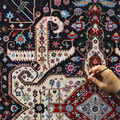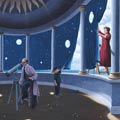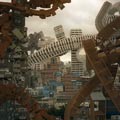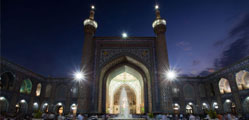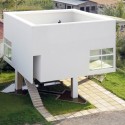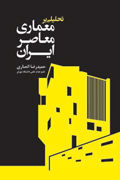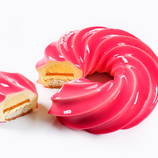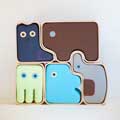قبلا یک بار با هم کارهای عجیب و شورانگیز Patrick Dougherty رو در قالب معماریهای رشدکردنی دیده بودیم. اما نظر به این که حیفه دوستانی که مخاطب جدید یانوندیزاین شدند هم نبینن این کارهای شگفت رو ، این پست رو که حاوی عکسها و مطالب بمتفاوت و دقیقتری از سری کارهای این بنده خداست ، این جا می گذارم.
معماری رشد کننده و زنده یکی از دغدغههای جدی زمانه ماست و خیلی ها اتودهایی در این باره داشتند و دارند. اما کارهای Patrick Dougherty به دلیل این که به نتایج روشن عینی خوبی هم دست پیدا کرده حائز اهمیته.
Patrick Dougherty is best known for his sculptures that break down over time. You may have seen one of his temporary works without realizing it. Built primarily from tree saplings woven together, each sculptures is approximately a three-week construction project where Dougherty and his group of volunteers carefully create the habitat or environment of this a tangled web of all natural materials. Because the sculptures are made of organic matter they disintegrate, break down and fall apart, becoming part of the landscape once again. Most people see habitats and shelters in his work – which is what many of them are meant to be – but “castles, lairs, nests and coccoons” isn’t what usually comes to mind. In an interview with Dougherty for the New York Times, Penelope Green discusses his only permanent work and the origin of his interest in what is referred to as Stickwork, now available through Princeton Architecture Press.
Patrick Dougherty has made over 200 sculptures in the 25 years that he has been creatingStickwork. But his construction work began when he was 28, working for the Air Force in the health and hospital administration. He decided to buy property in North Carolina and build his own house from the materials on the site. Collecting fallen branches, rocks and old timber, Dougherty was able to construct his home, in which he still lives with his wife and son, with a few additions. By 36, Dougherty decided to return to school for sculpture and attended the art program at the University of North Carolina. His interest in what nature had to offer led him to develop his tangled sculptures. Each sculpture is different and depends greatly on the site. Each project is different and depends on the volunteers that participate and the public that never fails to stop and watch the sculptures being woven together.
View some of his projects after the break.
Just Around the Corner; New Harmony, IN; April 2003; Mixed hardwoods
Just Around the Corner evokes the ancient construction of town dwellings that may have once occupied this site. The five elements resemble huts and are built into the hedge as though they are supporting the weight of trees and are a permanent fixture within this landscape. The more closely resemble homes built out of trunks than as tree saplings woven together. On site, the installation exists at right angles to the shops on the adjacent Main Street, creating a sharp contrast between the contemporary town architecture just beyond the hedge and the potentially ancient construction nearby.
Na Hale ‘Eo Waiawi; Contemporary Art Museum in Honolulu, HI; July 2003; Strawberry guava, rose-apple, and monkey pod
“Na Hale ‘o waiawi” can be roughly translated into English as “wild dwellings built from strawberry guava”, which explains quite accurately Dougherty’s intentions with this work. Using the materials available on the site, Dougherty chose the monkey pod tree which grew in the back lawn of the museum. He used it as a foil for the sapling sculpture which surged around the branches and trunk of the tree turning its limbs into inhabitable pods.
Spinoffs; De Cordova Museum and Sculpture Park in Lincoln, MA; Spring 1990; Maple Saplings
In this piece, Dougherty interacts with the architectural form of the building, responding to the pointed towers of the Museum. The sculpture grows off of the tower closest to the pond, falls to the next roof and continues down to a final conical form on the ground. The forms produce a dynamic swirling pattern that looks as though it is sweeping parts of the building away or is being swept up by it until it reaches its resting place on the ground. Where the sculpture touches down with the ground, the tree woven structure resembles a serf dwelling, “completing the metaphor linking the conical shape of a castle tower with that of a serf’s dwelling”, writes Dougherty.
Toad Hall; Santa Barbara Botanic Garden in Santa Barbara, CA; February 2005; Willow
Toad Hall is part of series called California Mission Series which is an ode to the history of California’s settlement. The works are reminiscent of these Catholic Missions that were established by early Spanish settlers. The architecture of this series mimics the Santa Barbara Mission. It too has a central dome and a maze of courtyards and evokes the local history of the project.
Running in Circles; TICKON Sculpture Park in Langeland, Denmark; April 1996; Mixed Hardwoods
Running in Circles takes the forces of the wind as the inspiration for sprawling, sweeping sculpture of saplings. The coastal poplar trees are the supportive elements of the sculpture, conducting the artist’s work as it makes its way among the trees. The large swirling ovals were designed to provide views from the road to the ocean just beyond the grove of trees. The nature of the sculpture also provides habitats and homes for small animals and resting places and vantage points for visitors.
Just for Looks; Max Azria Melrose Boutique in Los Angeles, CA; November 2006; Willow
Again by associating with the context of the site, this facade “spruce up” was designed with Max Azria’s Boutique in mind. Since paisley fabric uses plant-motifs in recurrent patterns, the sculpture envelopes the store in the natural material as a fabric. It is woven into a surface of swirls and eddies that Dougherty refers to as a “new set of party clothes for the building”.
Close Ties; Scottish Basketmakers Circle in Dingwall, Scotland; May 2006; Willow
Close Ties was inspired in both form and function by the ancient stone circles of Calanis in Scotland. The willow saplings were woven in primal stone shapes creating a central gathering point similar to those constructed by the early builders of the stone circles. The circles were known for their use as a meeting point of ceremony and celebration in which a public presentation would be performed. In the spirit of this tradition, the work was celebrated the following spring with a music and dance festival. The sculpture was burned in celebration for the festivities.
Call of the Wild; Museum of Glass in Tacoma, WA; June 2002; Willow plus vine maple, redtwig dogwood, and bitter cherry
In this sculpture, Dougherty is not referring to Jack London’s work by the same name. Instead he chose the phrase for its implications: “I am interested in our relationship to the natural world and how the idea of “wilderness” seems to have changed from a concept of “man against the elements” to a discussion of Nature’s fragility in the face of pollution, global warming, loss of species.” The piece sites familiar garden elements of urns, transformed by the nature of the material into wild forms.
Patrick Dougherty has a list of upcoming works; check them out if you are in the area and visithttp://stickwork.net for more info.
via At Home with Patrick Dougherty by Penelope Green, New York Times




